Jeanneau Sun Odyssey 40.3
An updated version of a popular cruiser comes with the benefit of boatbuilding experience
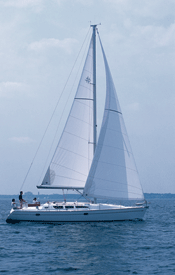 When you step aboard the new Sun Odyssey 40.3, you know you're on a Jeanneau-built boat. Features you've seen on other boats in the Jeanneau line abound, details and components-the sleek-looking hull, low cabinhouse with abundant windows and portholes to flood the interior with light, the comfortable cockpit-that have been tested and refined and proven to work on countless designs sailed by thousands of owners. The continuity of the technology is one of the advantages of boats produced by large production boatbuilders such as Jeanneau.
When you step aboard the new Sun Odyssey 40.3, you know you're on a Jeanneau-built boat. Features you've seen on other boats in the Jeanneau line abound, details and components-the sleek-looking hull, low cabinhouse with abundant windows and portholes to flood the interior with light, the comfortable cockpit-that have been tested and refined and proven to work on countless designs sailed by thousands of owners. The continuity of the technology is one of the advantages of boats produced by large production boatbuilders such as Jeanneau.
Of course, there are new twists as well, such as the twin steering wheels that improve both the helmsman's visibility and the functionality of the cockpit.
The 40.3 is a direct descendant of the Sun Odyssey 40, an evolution of a design that is meant to offer a lot of boat for the money with space filled with features for comfortable cruising and a substantial feel that implies seaworthiness. The 40.3 name refers more to the design's version than its size, which is actually a hull length of about 39 feet. The design by Daniel Andrieu has the same hull as its predecessor, but a new deck and interior. The hull is hand-laid glass with vinylester and polyester resins. It is the first Jeanneau to have a structural grid built separately and added after the hull is laid up, a more economical process. The mast is deck stepped. The 40.3 has the sturdiness you'd expect from a name like Jeanneau and the comfort of a much larger boat, for a $167,000 base boat price.
The hull is hand-laid glass with vinylester and polyester resins. It is the first Jeanneau to have a structural grid built separately and added after the hull is laid up, a more economical process. The mast is deck stepped. The 40.3 has the sturdiness you'd expect from a name like Jeanneau and the comfort of a much larger boat, for a $167,000 base boat price. We tested hull No. 11, which resided at Larsen Marine in Waukegan, Illinois, and outfitted with the optional in-mast furling mainsail and iron shoal keel. Docked next to other Jeanneau models, the 40.3's French pedigree was even more apparent and I was immediately impressed with the uncluttered deck and spacious cockpit. The standard teak cockpit seats and transom are a very handsome touch, and the optional teak decks will certainly add an air of class to the overall look of the boat.
We tested hull No. 11, which resided at Larsen Marine in Waukegan, Illinois, and outfitted with the optional in-mast furling mainsail and iron shoal keel. Docked next to other Jeanneau models, the 40.3's French pedigree was even more apparent and I was immediately impressed with the uncluttered deck and spacious cockpit. The standard teak cockpit seats and transom are a very handsome touch, and the optional teak decks will certainly add an air of class to the overall look of the boat.
Down below
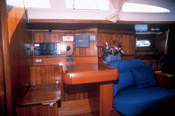 Stepping down below and into the spacious saloon, the benefit of Jeanneau's experience is immediately apparent. The companionway stairs are curved. The interior is made of Burmese teak, which gives it a rich look. This boat has the more popular two-cabin configuration, which obviously lends itself to more space than the three-cabin version, which compromises space in the aft head and saloon to make way for a second aft cabin and a separate forward head.
Stepping down below and into the spacious saloon, the benefit of Jeanneau's experience is immediately apparent. The companionway stairs are curved. The interior is made of Burmese teak, which gives it a rich look. This boat has the more popular two-cabin configuration, which obviously lends itself to more space than the three-cabin version, which compromises space in the aft head and saloon to make way for a second aft cabin and a separate forward head. 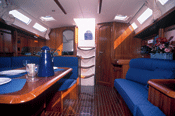 At the bottom of the companionway, the large galley is to starboard. A two-burner stove and oven are tucked in the corner, leaving a large amount of counter space to prepare a gourmet dinner. The refrigerator is impressive in its size, so deep that leftovers could go through several color changes before they emerge. Even more counter space is garnered by handy sink covers. The storage solutions in the galley are ingenious. Behind the counter, cupboards come with pre-drilled peg holes for sturdy dish storage, and a fold-down bin offers a good amount of space for large boxes or bags of food. Under the sink, one door opens to expose the garbage bin with a self-opening lid. The other door opens to give access to pull-out plastic bins perfect for storing plates or can goods in a secure spot.
At the bottom of the companionway, the large galley is to starboard. A two-burner stove and oven are tucked in the corner, leaving a large amount of counter space to prepare a gourmet dinner. The refrigerator is impressive in its size, so deep that leftovers could go through several color changes before they emerge. Even more counter space is garnered by handy sink covers. The storage solutions in the galley are ingenious. Behind the counter, cupboards come with pre-drilled peg holes for sturdy dish storage, and a fold-down bin offers a good amount of space for large boxes or bags of food. Under the sink, one door opens to expose the garbage bin with a self-opening lid. The other door opens to give access to pull-out plastic bins perfect for storing plates or can goods in a secure spot.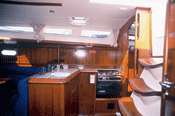 Opposite the galley is a good-sized nav station, with a table big enough to fold out a chart and a curved seat to hold you in when the boat is heeling.
Opposite the galley is a good-sized nav station, with a table big enough to fold out a chart and a curved seat to hold you in when the boat is heeling.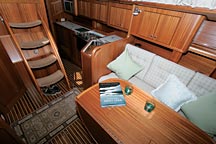 Speaking of heeling, one glance around the saloon and you'll notice the apparent absence of handholds. But oversized fiddles on every horizontal surface offer a sturdy and natural handhold that makes getting though even this beamy interior a breeze.
Speaking of heeling, one glance around the saloon and you'll notice the apparent absence of handholds. But oversized fiddles on every horizontal surface offer a sturdy and natural handhold that makes getting though even this beamy interior a breeze.
A U-shaped settee, standard fare for new boats, is to starboard with ample seating space for a large dinner crowd. As an option, owners can choose to have a dinette that converts to a double berth. Another slightly curved settee is on the port side, divided by a built-in table. The large V-berth forward serves as the owner's cabin and conveniently, in the two-cabin version, the bunk has more of a rectangular shape than the crammed-foot, sharp V-type bunk. There is gobs of storage underneath the bunk and a handy flip-open storage area on the aft end of the bunk perfect for shoes or everyday needs. The three-cabin version has a full head forward, but the two-cabin version offers just a vanity in the owner's cabin, which is a really nice way to save space for things you really need.
A large double bunk is aft, although most if it is under the lazarette and cockpit sole, so there is not a lot of headroom. The head is accessed through a separate door just aft of the nav station, and a glass divider separates the vanity from the toilet and shower area. A large door on the back side of the head accesses a handy storage area/workshop in the shallow area under the lazarette, perfect for extra sail storage or other not-frequently-used items. A built-in tool organizer near the front of the storage compartment is a clever addition.
The workshop area houses two of the four batteries and also provides access to the engine, which can also be accessed under the companionway steps and through the aft cabin. The other two batteries are stored under the aft bunk. All of the floor boards lift for bilge access.
On deck
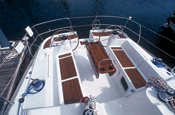 We slipped the docklines, backed out of the slip, and found out that the 56-horsepower Yanmar engine provides plenty of get-up-and-go for the 17,549-pound boat. The engine was remarkably quiet on deck. The engine control panel and throttle are mounted on the starboard steering station, so all maneuvering under power will happen from that side of the boat.
We slipped the docklines, backed out of the slip, and found out that the 56-horsepower Yanmar engine provides plenty of get-up-and-go for the 17,549-pound boat. The engine was remarkably quiet on deck. The engine control panel and throttle are mounted on the starboard steering station, so all maneuvering under power will happen from that side of the boat.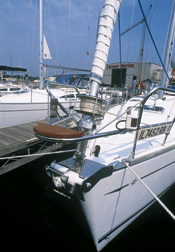 When we cleared the harbor mouth we swung into the wind and set the main-about a 30-second procedure with the in-mast furler. Such furling systems have their drawbacks in the form of sail shape and performance but anyone who dreads setting the main because of the inevitable struggle that comes later when they have to take it down will appreciate the ease and peace of mind that comes with this option. Just as quickly we unfurled the genoa and eased off on a reach.
When we cleared the harbor mouth we swung into the wind and set the main-about a 30-second procedure with the in-mast furler. Such furling systems have their drawbacks in the form of sail shape and performance but anyone who dreads setting the main because of the inevitable struggle that comes later when they have to take it down will appreciate the ease and peace of mind that comes with this option. Just as quickly we unfurled the genoa and eased off on a reach.
The twin steering wheels, perhaps the most obvious difference from its predecessor, are a real plus. There is plenty of space between them to walk to the swim-step transom, which has a separate, offset fold-down ladder. Instruments are found at each steering station and a chartplotter is cleverly mounted on the back of the cockpit table where the helmsman can easily use it. The test boat had the optional teak cockpit table with a built-in icebox that drains to the scuppers. An optional dodger would make the cockpit a haven in even the foulest weather.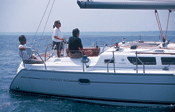 Harken winches and deck hardware are standard, although an extra pair of winches will need to be added for owners opting for the spinnaker package. All control lines are led to the cockpit, so there is rarely a need to leave those comfy confines, but when you do it requires a big step over the angled cockpit coamings. Thanks to the molded nonskid and plenty of handholds on the cabinhouse, walking forward is not an exercise in fear aversion. On the bow, an electric windlass is standard, and feeds anchor rode into a cavernous locking locker.
Harken winches and deck hardware are standard, although an extra pair of winches will need to be added for owners opting for the spinnaker package. All control lines are led to the cockpit, so there is rarely a need to leave those comfy confines, but when you do it requires a big step over the angled cockpit coamings. Thanks to the molded nonskid and plenty of handholds on the cabinhouse, walking forward is not an exercise in fear aversion. On the bow, an electric windlass is standard, and feeds anchor rode into a cavernous locking locker.
The aluminum rig stands 54 feet, 6 inches off the water, and features slightly swept-back spreaders and split, fixed backstay. The shrouds are inboard to avoid disturbing the genoa sheeting angle. The main is sheeted at midboom, with a short traveler forward of the companionway. The traveler was cross-rigged, and took a while to get used to pulling the opposite line than you normally would.
Under sail
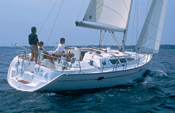 As we reached along in a building 9-knot breeze the 40.3's speedo hovered around the 5-knot mark. The boat was markedly stable, handling occasional powerboat wakes with ease. The comfortable, slightly angled helmsman seats were perfectly positioned to make steering from either side a pleasure.
As we reached along in a building 9-knot breeze the 40.3's speedo hovered around the 5-knot mark. The boat was markedly stable, handling occasional powerboat wakes with ease. The comfortable, slightly angled helmsman seats were perfectly positioned to make steering from either side a pleasure.
As we came up into the wind the 40.3 perked up and was increasingly responsive. Handing off the helm to enjoy the ride, I checked out the cockpit, which I found to be just as comfortable when we were heeling as it was when we were sitting at the dock. The deck was easy to negotiate under way thanks to the clean layout and convenient positioning of handholds.
But as the wind speed increased, things got exciting. As the breeze topped 10 knots, the 40.3 came to life, clipping along effortlessly. When a brief 14-knot puff came along, the Jeanneau accelerated nicely.
The helm required a light touch and at first I found myself oversteering. Once settled into the groove, though, only the slightest adjustment was needed to keep it on track. Tacking was no problem with the convenient cockpit set-up and it was obvious the 40.3 was designed to be easily sailed short-handed.
When it was time to head for the harbor, we went down to a broad reach, set the optional autopilot and enjoyed a nice sail in with the speedo hovering near 8 knots. We sailed almost all the way to the harbor mouth, knowing that dousing the sails was as simple as turning into the wind and furling them both. While we powered back to the slip, I popped below to check the engine noise and found it to be relatively quiet. The extra soundproofing around the engine box was doing its job.
Back in the slip-getting there was easy thanks to the three-blade fixed prop-we had another opportunity to lounge in the cockpit. It wasn't difficult to imagine ourselves relaxing at anchor, enjoying an icy cold beverage from the cockpit icebox and planning where the next day's sail would take us. That's probably what designer Andrieau had in mind when he worked on the 40.3-a nice-sailing boat for summer cruising with all the comforts of home.

Comments